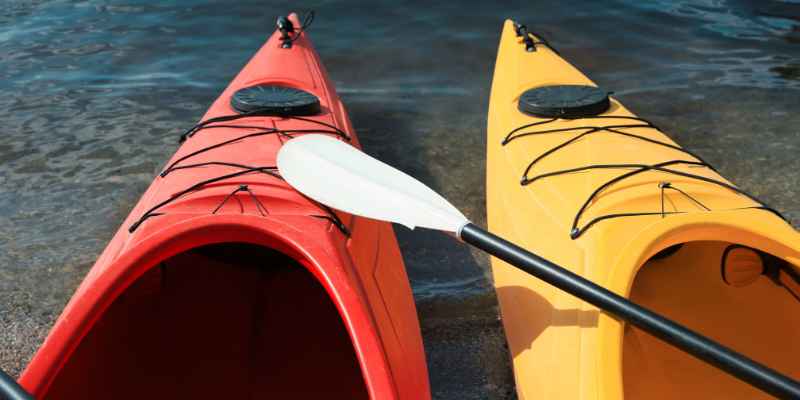To build a plywood kayak, you need to follow these steps: 1. Select a kayak design and gather the necessary materials.
2. Cut the plywood into the required shapes and assemble the kayak using epoxy resin and fiberglass cloth.
Introduction To Plywood Kayaking
When it comes to exploring the tranquil waters, kayaking is an excellent way to connect with nature. For those seeking a cost-effective and rewarding DIY project, building a plywood kayak is a fantastic option. In this introduction to plywood kayaking, we will delve into the appeal of DIY kayaks and the benefits of using plywood in boat building.
The Appeal Of Diy Kayaks
DIY kayaks offer a sense of satisfaction and pride that comes from creating your own watercraft. Building a plywood kayak allows for customization to suit individual preferences, making it a unique and personal endeavor. The process of constructing a kayak from scratch also fosters a deep connection with the finished product, enhancing the overall kayaking experience.
Benefits Of Plywood In Boat Building
Plywood is a popular choice for boat building due to its versatility, affordability, and ease of use. The strength-to-weight ratio of plywood makes it an ideal material for constructing durable and lightweight kayaks. Its inherent buoyancy and resistance to water damage make plywood a practical and reliable option for building watercraft. Additionally, plywood’s availability and workability make it a preferred choice for DIY enthusiasts embarking on a kayak-building project.
Tools And Materials Needed
When building a plywood kayak, having the right tools and materials is crucial for a successful and enjoyable construction process. From cutting and shaping the plywood to assembling the kayak, the tools and materials you use will directly impact the quality and durability of the finished product. Let’s take a look at the essential tools and the right plywood and supplies needed for this project.
Essential Tools For The Job
Here are the essential tools required to build a plywood kayak:
- Measuring tape
- Circular saw or jigsaw
- Clamps
- Sandpaper
- Drill and drill bits
- Screwdriver
- Paintbrushes
- Epoxy resin and hardener
- Woodworking rasp
- Wood glue
Choosing The Right Plywood And Supplies
When it comes to choosing the plywood for your kayak, opt for marine-grade plywood as it is durable and water-resistant. Additionally, you will need the following supplies:
- Marine-grade plywood
- Fiberglass cloth
- Epoxy resin
- Copper wire
- Wood screws
- Wood filler
- Masking tape
- Disposable gloves
- Eye protection
- Dust mask
Designing Your Kayak
Designing your kayak is a crucial step in building a plywood kayak that meets your specific needs and preferences. This involves carefully considering the key elements that contribute to the stability and performance of the kayak, as well as creating a detailed blueprint for your project.
Key Considerations For Stability And Performance
When designing your plywood kayak, it’s essential to prioritize stability and performance. The shape and dimensions of the kayak, as well as the distribution of weight, play a significant role in determining its stability on the water. Additionally, factors such as the hull design and the positioning of the bulkheads can impact the kayak’s overall performance. Ensuring a proper balance between stability and maneuverability is essential for an enjoyable kayaking experience.
Creating A Blueprint For Your Project
Before diving into the construction phase, creating a detailed blueprint for your plywood kayak is imperative. This blueprint should include precise measurements, a comprehensive layout of the kayak’s structure, and a clear depiction of the assembly process. By meticulously planning out the design, you can minimize errors during construction and ensure that the final product aligns with your vision.=
Cutting The Plywood

When building a plywood kayak, the process of cutting the plywood is crucial for ensuring precise construction.
Measuring And Marking With Precision
Before cutting, accurately measure and mark the plywood to avoid mistakes later on.
Safety Tips For Using Power Tools
- Wear protective goggles and gloves when operating power tools.
- Ensure the work area is well-ventilated to prevent inhalation of sawdust.
- Keep hands away from the saw blade and follow all safety instructions.
Assembling The Hull
Crafting a plywood kayak involves meticulously assembling the hull, ensuring precise alignment for a sturdy build. By following detailed instructions, carefully join each panel to create the kayak’s sleek and durable structure. This step sets the foundation for a successful and rewarding kayak-building project.
Stitch And Glue Method Explained
The stitch and glue method is a popular technique used to assemble a plywood kayak. It involves stitching the panels of the kayak together and then gluing them. The process is relatively easy and can be completed by beginners. Here are the steps to follow:
- Place the panels of the kayak on a flat surface and align them properly.
- Drill holes along the edges of the panels using a drill bit.
- Insert copper wire through the holes to stitch the panels together.
- Once the panels are stitched, apply epoxy glue to the seams.
- Allow the glue to cure for at least 24 hours.
- Remove the copper wire and sand the seams.
Reinforcing The Structure For Durability
To ensure that the kayak is durable, it is important to reinforce the structure. Here are some ways to do it:
- Apply fiberglass tape to the seams and coat it with epoxy resin.
- Install bulkheads to provide structural support and to create watertight compartments.
- Add a keel strip to protect the bottom of the kayak from wear and tear.
- Install deck beams to provide additional support to the deck.
By following these steps, you can assemble a plywood kayak that is strong and durable. The stitch and glue method is easy to learn and can be completed by anyone with basic woodworking skills. Reinforcing the structure will ensure that your kayak lasts for many years to come.
Adding The Deck And Cockpit
Crafting a plywood kayak involves adding the deck and cockpit, crucial steps that require precision and attention to detail. By carefully shaping and attaching the plywood panels, you create a sturdy structure for your kayak. This process sets the foundation for a successful build, ensuring a reliable and functional watercraft.
Crafting A Comfortable Seating Area
Begin by ensuring the plywood kayak’s cockpit fits your body comfortably. Use foam padding to customize the seat shape.
Sealing And Attaching The Deck
Apply marine-grade sealant to the edges of the deck for waterproofing. Secure the deck to the hull using marine epoxy glue.
Waterproofing And Finishing Touches
To ensure your plywood kayak is watertight, waterproofing and finishing touches are essential. Apply a marine-grade epoxy to seal the wood and protect it from water damage, and then sand and varnish the exterior for a professional and durable finish.
These steps will enhance the longevity and performance of your handmade kayak.
Waterproofing and finishing touches are the final steps in building your own plywood kayak. Choosing the best sealants and paints is crucial to protect your kayak from water damage and wear and tear. Applying the final protective layers will provide a smooth and polished finish that will not only make your kayak look great but also increase its durability and longevity.
Choosing The Best Sealants And Paints
When it comes to sealants and paints for your plywood kayak, there are a variety of options available. However, not all sealants and paints are suitable for marine applications. It is important to choose the right sealant and paint that will provide maximum protection against water damage and UV rays.
To ensure the best protection for your plywood kayak, consider using marine-grade sealants and paints. These products are specifically designed for marine applications and can withstand harsh weather conditions and saltwater exposure. Some popular marine-grade sealants include silicone, polyurethane, and epoxy.
Applying The Final Protective Layers
After selecting the best sealant and paint for your plywood kayak, it is time to apply the final protective layers. Before applying the sealant, make sure to sand the surface of the kayak to ensure a smooth finish. This will also help the sealant adhere better to the surface.
Once the surface is sanded, apply the first coat of sealant using a brush or roller. Allow the sealant to dry completely before applying the second coat. Repeat this process until you have applied the recommended number of coats.
After applying the sealant, it is time to paint the kayak. Apply the first coat of paint using a brush or roller and allow it to dry completely before applying the second coat. Repeat this process until you have achieved the desired finish.
In conclusion, waterproofing and finishing touches are essential steps in building your own plywood kayak. Choosing the best sealants and paints and applying the final protective layers will ensure that your kayak is protected from water damage and looks great for years to come.
Safety And Maintenance Tips

Discover essential safety and maintenance tips for building a plywood kayak. Prioritize proper ventilation and eye protection during the construction process. Regularly inspect the kayak for any signs of wear and tear, and ensure proper storage to prolong its lifespan.
Safety Gear And Precautions For Paddling
When it comes to kayaking, safety should always be a top priority. Before you hit the water, make sure you have all the necessary safety gear, including a life jacket, helmet, and appropriate clothing. It’s also important to be aware of weather conditions and any potential hazards in the water, such as strong currents or obstacles. Always let someone know where you’re going and when you’ll be back, and consider taking a safety course or paddling with an experienced kayaker.
Regular Kayak Care For Longevity
Proper maintenance is key to ensuring your plywood kayak lasts for many years of paddling adventures. After each use, rinse off your kayak with fresh water and dry it thoroughly to prevent mold and mildew growth. Store your kayak in a dry, cool place, and inspect it regularly for any signs of damage or wear. If you notice any cracks or holes, repair them promptly to prevent further damage.
Taking the time to properly care for your plywood kayak and prioritize safety while paddling can help you enjoy many happy years on the water. By investing in quality safety gear, being aware of your surroundings, and staying on top of maintenance tasks, you can ensure your kayak is always ready for your next adventure.
Launching Your DIY Kayak
Before setting out on your first kayak adventure, double-check all connections and fittings.
- Ensure the kayak is securely assembled.
- Inspect the hull for any potential issues.
After testing your kayak, make adjustments as needed:
- Check the seat for comfort.
- Refine the foot pedals for optimal positioning.
Conclusion: Joining The Kayaking Community
Immersing yourself in the vibrant kayaking community is a rewarding way to showcase your handmade plywood kayak. Connect with like-minded enthusiasts, share your building journey, and explore new waters together. Joining this community opens up endless opportunities for adventure and camaraderie.
Sharing Your DIY Experience
Once you have successfully built your own plywood kayak, it’s time to share your experience with others. By sharing your DIY experience with friends, family, and even strangers, you can inspire others to take up kayaking and start their own DIY projects. You can share your experience on social media platforms or online forums where like-minded individuals gather to discuss their experiences. This will not only help you connect with other kayaking enthusiasts but also help you learn more about kayaking from others who have been on the water longer than you.
Continuing The Journey With Kayak Adventures
Now that you have built your own kayak, it’s time to hit the water and start your kayaking journey. Whether you want to explore calm lakes or navigate through challenging rapids, kayaking adventures offer a unique experience that you can’t get anywhere else. You can join local kayaking groups or clubs to meet other enthusiasts and plan group trips. This will allow you to explore new places, learn new techniques, and make new friends who share your passion for kayaking.
In conclusion, building a plywood kayak is a rewarding experience that not only allows you to create a custom watercraft but also connect with other kayaking enthusiasts. By sharing your DIY experience and continuing your kayaking journey, you can explore new places, learn new techniques, and make new friends who share your passion for kayaking. So, get started on your DIY project today and join the kayaking community!
Frequently Asked Questions
What Are The Benefits Of Building A Plywood Kayak?
Building a plywood kayak is cost-effective, customizable, and allows for a sense of accomplishment in creating a functional watercraft.
How Long Does It Take To Build A Plywood Kayak?
The time to build a plywood kayak varies based on experience level, design complexity, and dedication, but typically takes 40-60 hours.
Is It Difficult To Build A Plywood Kayak As A Beginner?
Building a plywood kayak as a beginner is achievable with detailed instructions, patience, and some woodworking skills. It’s a rewarding learning experience.
Can A Plywood Kayak Be Customized To Fit Specific Needs?
Yes, plywood kayaks can be customized with different colors, designs, and additional features to suit individual preferences and requirements.
Conclusion
Building a plywood kayak can be a rewarding and fulfilling project for any outdoor enthusiast. By following the step-by-step instructions provided in this blog post, you can create a sturdy and reliable kayak that will provide countless hours of enjoyment on the water.
Remember to choose the right materials, take your time during the construction process, and ensure proper safety precautions are taken. So, get ready to embark on an exciting kayaking adventure with your very own handmade plywood kayak!


